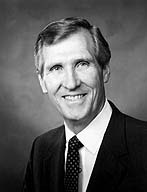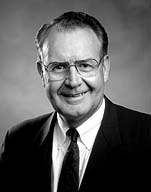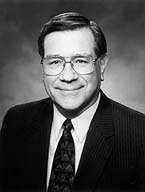“Conversation: The Church in Japan, Korea, and Far-East Russia,” Ensign, Nov. 1996, 110–12
Conversation: The Church in Japan, Korea, and Far-East Russia
While Japan and Korea have both long been centers of Church growth, far-east Russia (better known to many Westerners as eastern Siberia) is now showing early signs of growth. For an update about the Church in the Asia North Area, the Ensign spoke with Elder David E. Sorensen of the Seventy, Area President, and his counselors, Elders Rex D. Pinegar and L. Edward Brown also of the Seventy.



Elder Rex D. Pinegar Elder David E. Sorensen Elder L. Edward Brown
Question: Can you help us see the developments that have taken place in far-east Russia?
Answer: The Church’s Asia North Area includes the eastern half of the vast Russian province of Siberia, a portion that is home to some eight million people. Late in autumn 1994, terrible flooding was experienced along Russia’s Pacific coastline. The Church was able to send food, clothes, blankets, and medical aid to more than 5,000 needy families. As always, we provided this humanitarian aid without any thought or expectation of favors being returned by those assisted. However, we were pleased when, as a result of contacts made through the Church’s flood relief efforts, government agents extended an invitation that led to the calling of four humanitarian-service missionary couples to teach English, business, law, and accounting at a university in Vladivostok. The Church now has small branches in Vladivostok and Magadan. We look forward to seeing the gospel further progress on this new frontier.
Q: What are the developments that are taking place in Japan and Korea?
A: While Church growth in these two countries might appear slower by some standards, we are very pleased with the progress of members. Christians in Japan still represent only about 2 percent of the total population, but The Church of Jesus Christ of Latter-day Saints is the third largest Christian denomination in Japan.
We have more than 100,000 Japanese members organized into 25 stakes. In Korea, where Christians make up a much higher percentage of the population than in Japan, we have more than 60,000 members in 16 stakes. Further, despite the considerable cultural pressures working against members, retention and activity rates in both countries are improving.
It takes great courage and dedication to be a Latter-day Saint in Japan and Korea. The work ethic of these cultures is well known in terms of the time and energy workers routinely devote, and furthermore many employers expect a level of allegiance and commitment that many people would probably rather reserve for their family and religion. The Japanese have a saying that goes something like this: “The stick that sticks out needs to be pushed down.” With 125 million people inhabiting islands that together total less than the land mass of Montana in the United States, the Japanese have had to learn how to get along with each other very well. They have a strong, unified sense of community, and sometimes Church members are perceived as unsettling that community by being “sticks that stick out.” We are striving to change that perception by helping the Japanese see that Church members among them are sticks that strengthen the fiber of the whole.
Q: What efforts are going forth to improve people’s understanding of the Latter-day Saints in these two nations?
A: The area public affairs director has been working to set up public affairs councils in stakes throughout Japan and Korea to help members spread positive messages about the Church to the public. Members are using media resources to highlight what Latter-day Saint lifestyles and beliefs are all about. After the January 1995 earthquake in Kobe, for example, several positive articles were published in newspapers and magazines about the impact and timeliness of Church assistance. More than 150 articles about the Church and its members have appeared throughout Japan during the past year, and similar public affairs initiatives are going forth in Korea.
We are very excited about members’ great upsurge of interest in family history work, which naturally dovetails with the feelings of respect and reverence toward ancestors shared by most Asian cultures. Church members are taking the lead by setting up family history centers, using them, and inviting members of other faiths to take advantage of them. Despite other demands on their time and energy, many members are working very hard on their family histories. We know that this effort is blessing their lives and the growth of the Church in significant ways. In conjunction with family history work, the Seoul Korea and Tokyo Temples continue to be spiritual sanctuaries for members. In many stakes new converts are encouraged to perform baptisms for the dead, which helps them feel inspired with a desire to return to the temple soon to take out their own endowments and be sealed to their families.
Q: What are some other manifestations of strength among members?
A: We are increasingly seeing the fruits of the efforts and sacrifices of the pioneering first generation of Japanese and Korean members. A second generation is rising in strength and beginning to swell the ranks of missionaries and leaders. More than a quarter of the full-time missionaries serving in both countries are Japanese and Korean, and fully two-thirds of the young people who enter the Japanese missionary training center are second-generation members. In Korea, students who interrupt their university studies to serve a mission often face significant hurdles to resume their studies when they return, yet many choose to make this sacrifice. Also, all young men in Korea have a three-year commitment to serve in the armed forces. First-generation converts who have endured because of their faith and abiding testimonies are as strong as Latter-day Saints anywhere in the world.
The young people joining the Church are also a source of great strength. Because of the high costs of living and the rigors of gaining an education and starting a career, many people in Asian nations are increasingly delaying marriage until later in life. Church leaders are striving to be sensitive about the social mores that contribute to the large single population in the Church, yet at the same time they are teaching and encouraging them to make marriage an important priority. Latter-day Saints who choose to make marriage and family important priorities are being blessed for their efforts to live Heavenly Father’s plan.
One college student who recently joined the Church illustrates the courage that young Japanese and Korean converts demonstrate. This man was part of a somewhat rowdy group of friends. On a lark, they accepted the invitation of some missionaries to attend one of the English classes that are part of missionary labors in Asia and elsewhere. This young man decided to listen, and he came back a second time on his own. He began studying the Latter-day Saint scriptures to find something wrong, but instead he was converted. His parents were disturbed that perhaps his joining this new religion represented more rebellion, and his friends threw a party on the night of his baptism, hoping to divert him. However, he persevered with what he knew was right. Impressed with the changes in his life, the man’s parents and two of his friends recently started taking the missionary discussions.
Members in Japan are preparing to celebrate a significant milestone in their history. The Japanese Mission was opened by Heber J. Grant in 1901. In preparation for the centennial of the Church in Japan in 2001, a committee of members is compiling historical information and testimonies to be published in a book meant not only for the enjoyment and edification of members but also, through placement in libraries, to help tell the story of the Church to the public.
We cannot rehearse the strengths of members without mentioning the humanitarian efforts that are so vital and helpful to so many. Both countries are practically self-sufficient in tithes and fast offerings—in fact, often their contributions help support Church growth and assistance in other parts of the world. Church members’ response to the Kobe earthquake demonstrates their willingness to be prepared to help. Members helped set up temporary housing and soup kitchens, and food, clothing, and medical supplies poured in from members all over Japan. For three weeks, members filled five-gallon containers with water and brought them into the devastated areas. On the first Sunday in February 1995, members throughout the area held a special fast and earmarked their donations to help quake victims, including the 60 members who lost their homes.
Another manifestation of strength among members in Japan and Korea can be found in the international community. Tokyo has three English-speaking wards. Japan has two English-speaking military districts, and Korea has one. Also, students of Brigham Young University have become ambassadors of the Church as they participate in BYU’s successful, growing business internship program in Japan. In the military districts, sacrament meeting attendance is as high as 80 percent, which represents unusual dedication. Expatriates are loved and greeted with open arms by local members in both countries.
On the other hand, perhaps the most gratifying thing we observe among the Korean and Japanese members is a definite shift from leaning upon leaders closer to Church headquarters to accepting more responsibility for the destiny of the Lord’s Church in Asia. It thrills us to see this taking place. So many of Asia’s cultural values and practices are already in harmony with the principles of the gospel. Once they are truly converted, Asian members make devoted, dedicated Latter-day Saints.
We would also like to mention some of the positive results of recent visits to Japan and Korea by President Gordon B. Hinckley and Elder Joseph B. Wirthlin of the Quorum of the Twelve Apostles, who were in the Far East for the dedication of the Hong Kong Temple in May 1996. After a news conference in Tokyo, favorable articles about President Hinckley appeared in newspapers and magazines with a total readership of more than 12 million. After a news conference in Seoul, positive features appeared in 12 newspapers that reach over 20 million people. Reporters commented on President Hinckley’s wit, humor, and energy, and they seemed particularly interested in the prophet’s comments about the Word of Wisdom. President Hinckley was also quoted about the importance of families and the home, stating that the “basis of the human race and the family is peace at home. Homes should be filled with love and harmony. In order to cultivate a strong nation, we must cultivate strong homes.”
The Seoul Korea Temple.
Japanese family members enjoy an evening together as they participate in the Church’s family home evening program.